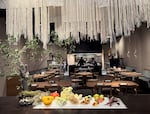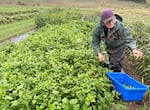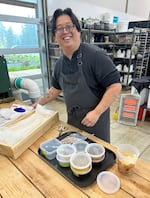The ōkta farm would be easy to miss if you weren’t looking for it. Tucked among dozens of vineyards about 15 miles outside of McMinnville, Oregon, the former cherry orchard sits at the top of Ribbon Ridge, giving full view of a rainy and overcast day.
“Okta is a British meteorology measurement. It’s eight grades [indicated by] circles, so the more the circle is filled in, the more cloud cover there is,” said Christine Langelier, the general manager of ōkta and Tributary Hotel, a boutique hotel and tasting menu restaurant that’s the brainchild of Katie Jackson and Shaun Kajiwara, both vineyard owners in Sonoma County, California, and Michelin-starred chef Matthew Lightner. “So today — a beautiful rainy day here in the Pacific Northwest — would be eight okta, a perfectly sunny day would be zero okta.”

Built in a 100-year-old former hardware store, ōkta restaurant sits in the main floor of the Tributary Hotel in downtown McMinnville, Ore. The intimate tasting menu restaurant was founded by Michelin-starred Chef Matthew Lightner and vineyard owners Katie Jackson and Shaun Kajiwara, both from Sonoma County, Calif.
Crystal Ligori / OPB
The farm was once an old cherry orchard, while the hotel and restaurant are located in a 100-year-old former hardware store in downtown McMinnville.
“We wanted to make sure it would be around for 100 more years,” Langelier explained. “So everything that we have done, whether it’s here on the farm or in the community of McMinnville, we’re trying to make sustainable practices.”
In fact, the entire project — from farm to restaurant — is focused on the idea of preservation. When Jackson and Kajiwara took over the cherry orchard, it was in poor condition with nearly all of the trees having succumbed to insects and disease. But now, the one-acre plot of land is thriving with rows of garden beds, two hoop-style greenhouses where they can farm year-round, a germination and propagation greenhouse, and a herd of 12 sheep that recently came from California.
Related: A radicchio revolution is underway in the Northwest
During the peak of farming season, the six weeks or so in the middle of summer, the goal is to have 85% of the produce on ōkta’s menu coming from their own farm, which Langelier admits is a lofty goal.
“If the farm gives back six carrots, that’s what you’re gonna get — six carrots,” she said. “You can’t ask the soil to just magically prepare 12 carrots for you.”
Nearly everything on ōkta’s farm was planted by farm manager Saruh Wynes, who was farming there long before the restaurant was open. That’s because in order to use the produce on ōkta’s menu, they have to plan months ahead.
“Me and the chef team are ideally fully collaborating on our farm plan,” Wynes said. “They give me an idea of what crops they want to feature in each season, and then I can go ahead and push forward with volumes and bed footage and such.”

Saruh Wynes harvests New Zealand spinach on the ōkta farm, Nov. 1, 2023. Wynes is the farm manager at ōkta's regenerative farm and single-handedly planted nearly everything growing on the one-acre plot.
Crystal Ligori / OPB
Giving food waste a second life
But the ōkta farm is not just a place for growing food; it’s also an experimental lab of sorts in the form of an on-site larder, with Larder Chef Larry Nguyen at the helm.
Historically, a larder was a food storage area kept cool in the days before refrigeration. In modern times, the concept has grown to encompass food preservation in general.
“Whether it’s dried, whether it’s held in oil, canned, whether it’s pickled, cooked into a jam… All of that encompasses a larder,” Nguyen said, with the main goal being to preserve what’s growing during the peak farming season and have it available in the months where things are more scarce.
Nguyen’s interest in food preservation grew alongside his traditional career as a chef working in restaurants in Washington state and Texas, and even around the world, including an internship in the fermentation lab of the iconic Danish restaurant noma.
“I eventually got to the point where I did get pretty good at this,” Nguyen said. “What if I were to commit to this? Not really do the kitchen side and what would happen if I was able to do this full time?”
Related: From dairies to restaurants, robots could be the future of food
The larder is filled with shelves of hand-labelled containers filled with things like a fine dust of electric-red tomato powder, glass jars packed with different varieties of dried peppers, and sheet trays stacked with charred celeriac that look like giant roasted marshmallows. At the center of it all, both physically in the larder and of Nguyen’s technique, are in the dozens of fermentation buckets.
“I’ve got a bunch of shoyu — a Japanese-style soy sauce — along with 30-ish kinds of miso,” he laughs. “When we were building the lab, one of the big things that I really wanted was that it showcases the region specifically, so in this case, the Willamette Valley.”
Nguyen sought out grains and beans, sourcing purple barley from Lonesome Whistle Farm in Junction City — about 69 miles south of McMinnville — to grow koji, and beans from Bernards Farm just down the road in McMinnville for the miso.

ōkta Larder Chef Larry Nguyen shares a variety of preservation techniques he's using at the farm's on-site larder on Nov. 1, 2023. His sampling ranges from koji grown on purple barley and white kimchi made with Caraflex cabbage, to miso and shoyu fermented from locally grown beans.
Crystal Ligori / OPB
Nguyen explained that ideally any produce not used at the restaurant “as-is” can be used for stocks, sauces and even the daily staff meal. But if it’s not being used fresh, it’s up to him to figure out what happens next.
“I have some dried chilies from three years ago that we’ve been able to get on the menu this past year,” he said. “That way we’re not losing them.”
Another example he points to is their white kimchi, made with Caraflex cabbage, Habanada peppers, green garlic and daikon all grown on their own farm — produce that a traditional restaurant may see just as waste.
“The daikon is actually from daikons that were imperfect that would never make it to the restaurant,” Nguyen said. “So instead of losing those, I simply wash them, cut them up and they make it into this kimchi, and then we end up having a second chance at it instead of just taking it for a loss.”
Using produce from the ōkta farm means the menu at ōkta restaurant has a distinct sense of place. And the preservation at their larder means the food grown there can go even further.
Related: Superabundant dispatch: A wild foods foray without the hike




